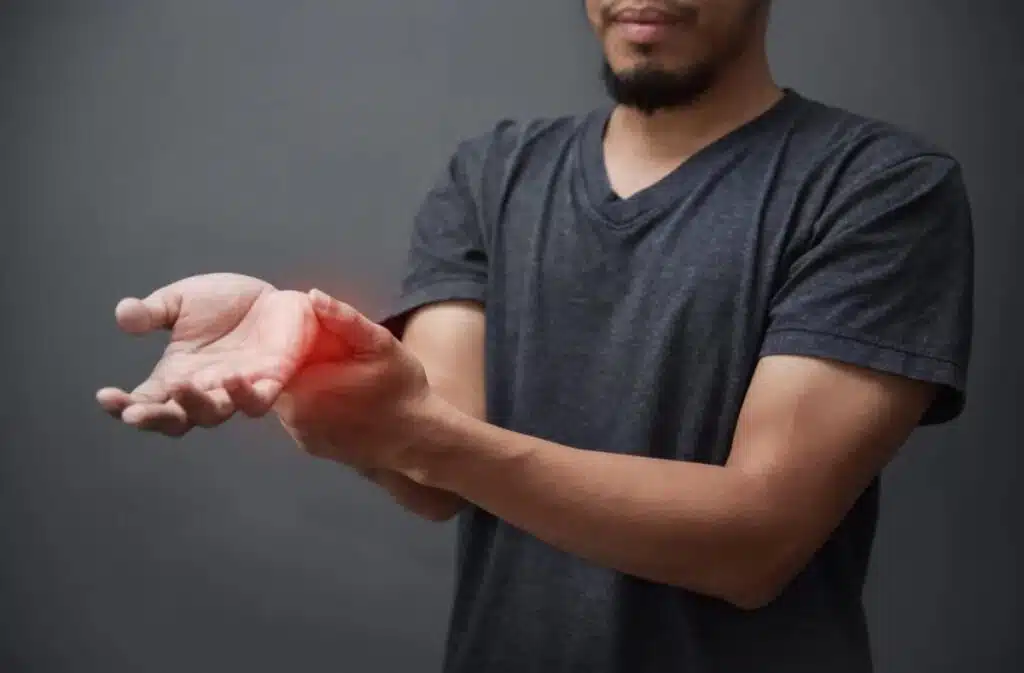This website uses cookies so that we can provide you with the best user experience possible. Cookie information is stored in your browser and performs functions such as recognising you when you return to our website and helping our team to understand which sections of the website you find most interesting and useful.

Call Us Today To Schedule Your Appointment.

The Triangular Fibrocartilage Complex (TFCC) is a crucial structure in the wrist that provides stability and support to the joint. It is a complex network of ligaments, cartilage, and tendons located on the wrist’s ulnar side (pinky side). The TFCC is essential for proper wrist function, as it helps distribute forces across the wrist joint and provides cushioning between the ulna (one of the forearm bones) and the wrist’s carpal bones.
A TFCC tear occurs when there is damage or disruption to any part of the TFCC structure. TFCC tears can result from acute injuries, such as falls onto an outstretched hand, sudden twisting of the wrist, or repetitive stress over time. They can also be associated with degenerative changes in the wrist joint, such as osteoarthritis or chronic overuse.
TFCC tears can cause significant pain and dysfunction in your wrist. Still, with appropriate diagnosis and treatment, many patients can achieve successful outcomes and return to normal activities with minimal long-term effects. It’s important to contact our office today for evaluation and treatment.
Contact our professional medical staff by calling us today.
Triangular Fibrocartilage Complex (TFCC) tear repair is a surgical procedure performed to address injuries to the TFCC, a structure located on the wrist’s ulnar side (pinky side). The TFCC is a complex structure of cartilage, ligaments, and tendons that helps stabilize the wrist and facilitate smooth movement.
Indications:
TFCC tears can occur due to traumatic injuries, such as falls onto an outstretched hand or degenerative changes over time. Symptoms of a TFCC tear may include pain, swelling, clicking or popping sensations, weakness, and limited range of motion in the wrist joint. Non-surgical treatments such as rest, immobilization, physical therapy, and medications may be attempted initially, but if symptoms persist or worsen, surgery may be recommended.
Surgical Procedure:
TFCC tear repair surgery is typically performed arthroscopically, using small incisions and a camera (arthroscope) to visualize and access the structures inside the wrist. During the procedure, Dr. Pournaras will remove any damaged or frayed tissue from the TFCC, repair torn ligaments or cartilage, and address any associated abnormalities or impingements in the wrist. In some cases, additional procedures such as debridement (removal of damaged tissue), stabilization of the distal radioulnar joint (DRUJ), or ulnar shortening may be performed concurrently, depending on the specific characteristics of the injury and the patient’s needs.
Diagnosis and treatment of a Triangular Fibrocartilage Complex (TFCC) tear typically involve a combination of clinical evaluation, physical examination, and imaging studies.
Diagnosis:
Clinical Evaluation: Your first appointment will begin by discussing the your symptoms, medical history, and any recent injuries or activities that may have contributed to your wrist pain. We may also perform specific tests to assess the stability, range of motion and tenderness of your wrist.
Physical Examination: During a physical examination, we will perform maneuvers to reproduce the patient’s symptoms, such as the ulnar fovea sign (tenderness over the ulnar aspect of the wrist), grinding test (ulnar-sided wrist pain with axial loading and ulnar deviation), or piano key test (pain or clicking with pressure applied to the TFCC).
Imaging Studies: X-rays may be obtained to assess for bony abnormalities, fractures, or signs of arthritis in the wrist.
MRI (Magnetic Resonance Imaging): MRI is the imaging modality for evaluating soft tissue structures like the TFCC. It can provide detailed information about the extent and location of the tear and any associated abnormalities in the wrist.
Arthroscopy: In some cases, arthroscopic examination of the wrist may be performed to directly visualize and assess the TFCC and other intra-articular structures.
Treatment: The treatment approach for a TFCC tear depends on factors such as the severity of the tear, the symptoms and functional goals, and any associated injuries or conditions.
Treatment Options May Include:
Rest: Avoiding activities that aggravate symptoms and allowing the wrist to rest can help reduce pain and inflammation.
Immobilization: Wearing a splint, brace, or cast to immobilize the wrist and protect the TFCC during the initial healing period.
Physical Therapy: Specific exercises and stretches to improve range of motion, strength, and stability of the wrist.
Medications: Nonsteroidal anti-inflammatory drugs (NSAIDs) or corticosteroid injections may be prescribed to help alleviate pain and inflammation.
Surgery: Arthroscopic Debridement: In cases of symptomatic TFCC tears that do not respond to conservative treatment, arthroscopic debridement may be performed to remove damaged tissue and debris from the TFCC, allowing for better healing and symptom relief.
Repair or Reconstruction: For more severe or complex TFCC tears, surgical repair or reconstruction of the TFCC may be necessary to restore stability and function to the wrist. This may involve suturing torn ligaments, using tissue grafts, or repairing or replacing damaged TFCC structures.
Recovery: After TFCC tear repair surgery, patients typically undergo a period of immobilization in a splint or cast to protect the surgical repair and allow for initial healing.
Physical therapy and rehabilitation are initiated gradually to restore the range of motion, strength, and function of the wrist joint. Rehabilitation exercises may include gentle stretching, strengthening exercises, and proprioceptive training to improve wrist stability and coordination. Full recovery from TFCC tear repair surgery may take several months, and patients may experience some stiffness, swelling, and discomfort during the healing process.
It’s important for patients to follow their postoperative instructions closely, attend all scheduled follow-up appointments, and communicate any concerns or changes in symptoms during the recovery period.
Outcome:
The success of TFCC tear repair surgery depends on factors such as the severity of the tear, the patient’s overall health, and adherence to postoperative rehabilitation. In general, many patients experience significant improvement in symptoms and function following surgery, and they are able to return to normal activities and sports participation over time.
However, it’s important to understand that full recovery may take several months, and some patients may continue to experience residual symptoms or limitations despite treatment.
Make Your Appointment Today
Fair Oaks Orthopedics – Fairfax,VA


